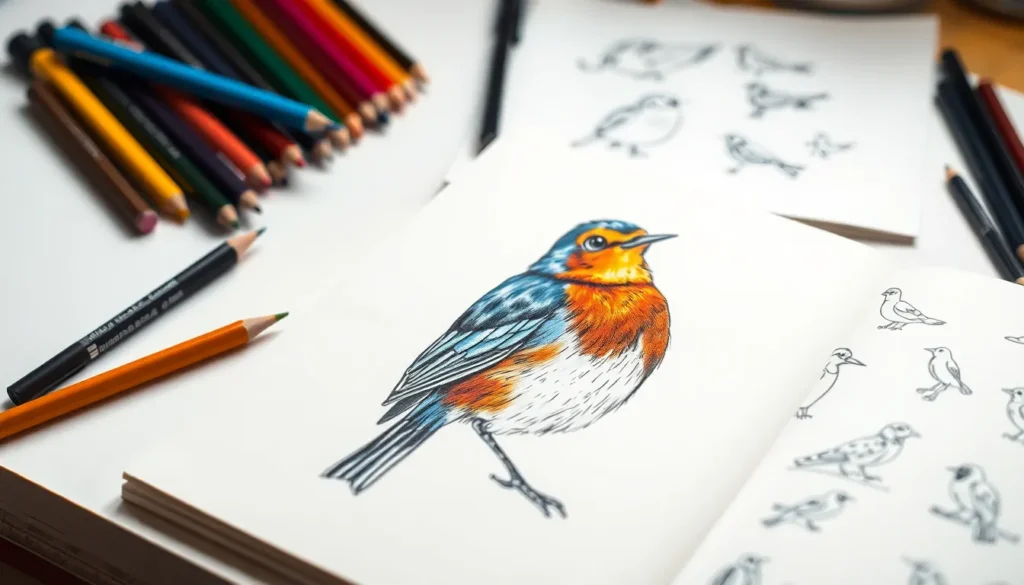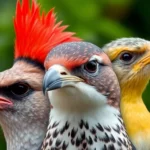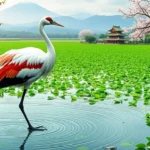We’ve all found ourselves mindlessly sketching during meetings or phone calls, and there’s something magical about those spontaneous bird doodles that grace our notebooks. Whether it’s a simple sparrow silhouette or an elaborate eagle in flight, bird doodles represent one of the most universal and timeless forms of artistic expression.
These charming sketches aren’t just random scribbles – they’re windows into our creativity and relaxation. From beginners picking up their first pencil to seasoned artists looking for inspiration, bird doodles offer the perfect blend of simplicity and artistic challenge. They’re forgiving enough for novices yet sophisticated enough to captivate experienced drawers.
We’re about to jump into the wonderful industry of bird doodle art, where every stroke tells a story and every feather brings joy. You’ll discover techniques that’ll transform your simple sketches into captivating creatures that soar right off the page.
Easy Bird Doodle Techniques for Complete Beginners
Starting your bird doodle journey doesn’t require advanced artistic skills or expensive materials. We’ll explore fundamental techniques that transform basic lines and shapes into charming avian characters.
Basic Line Drawing Methods
Curved line foundations create the most natural bird doodle appearances. Begin with a gentle arc for the bird’s back, then add a smaller curve underneath to form the belly. Connect these curves at both ends to establish your bird’s basic body shape.
Single stroke techniques work exceptionally well for minimalist bird doodles. Draw one continuous line starting from the tail, flowing through the back, over the head, down the chest, and back to complete the body. This method produces elegant silhouettes that capture a bird’s essence with minimal effort.
Overlapping line combinations add depth and dimension to your doodles. Start with the body outline, then layer additional lines for wing details, tail feathers, and head features. Each new line should slightly overlap the previous ones to create visual cohesion.
Simple Shape-Based Approaches
Circle and oval constructions form the foundation of most beginner bird doodles. Use a large oval for the body positioned horizontally, then add a smaller circle for the head. This basic framework works for robins, sparrows, and countless other bird species.
Triangle integration enhances your bird doodle’s recognizable features. Add a small triangle for the beak pointing away from the head circle. Create tail feathers using elongated triangles extending from the body’s rear. Wing shapes emerge naturally from triangular forms layered over the body oval.
Teardrop formations produce ever-changing flying bird poses. Start with a teardrop shape pointing diagonally upward for soaring birds. The wider end becomes the head area while the pointed end transforms into streaming tail feathers.
Essential Tools and Materials
Basic drawing implements include standard pencils, fine tip pens, and regular paper. We recommend starting with a 2B pencil for initial sketches since it erases easily and creates smooth lines. Black gel pens with 0.5mm tips work perfectly for final line work and details.
Paper selections significantly impact your bird doodle experience. Smooth drawing paper prevents pen skipping and allows for clean line work. Sketch pads with medium weight paper (around 70gsm) provide enough durability for erasing and reworking areas.
Optional enhancement supplies include colored pencils for adding personality and kneaded erasers for gentle corrections. White gel pens create beautiful highlights on darker papers, while blending stumps smooth pencil shading for more polished results.
Popular Bird Doodle Styles to Master

Building on our foundational bird doodle techniques, we can now explore distinctive artistic approaches that transform simple sketches into memorable artwork. These three popular styles offer unique challenges and creative opportunities for developing our bird drawing skills.
Minimalist Single-Line Birds
Continuous line drawings capture the essence of birds using one unbroken stroke from start to finish. We create these elegant designs by planning our path before touching pen to paper, visualizing how each curve flows into the next. The key lies in maintaining fluid motion while our hand traces the bird’s silhouette, wings, and defining features without lifting the drawing tool.
Essential elements for successful single-line bird doodles include smooth transitions between body sections and strategic placement of characteristic details like beaks, tails, and wing tips. We achieve visual impact through varying line weight, applying more pressure during important features and lighter touches for subtle details. Popular subjects include flying swallows, perched songbirds, and graceful herons that naturally lend themselves to flowing line work.
Practice techniques involve starting with simple bird profiles before attempting complex poses or multiple birds in one continuous line. We recommend beginning with basic shapes like circles for heads and ovals for bodies, then connecting these forms with sweeping strokes that suggest movement and life.
Cartoon-Style Bird Characters
Character development transforms ordinary bird doodles into expressive personalities through exaggerated features, vibrant expressions, and playful proportions. We design these whimsical creations by enlarging heads relative to bodies, creating oversized eyes that convey emotion, and adding distinctive accessories or clothing elements that give each bird unique characteristics.
Popular cartoon approaches include round, chubby birds with stubby wings like angry birds, tall thin birds with long necks resembling cartoon cranes, and small fluffy birds with disproportionately large beaks. We enhance personality through facial expressions, using raised eyebrows for surprise, half-closed eyes for sleepy characters, or wide grins for happy birds. Adding simple backgrounds like tree branches, clouds, or geometric patterns helps establish context and mood.
Color and style choices play crucial roles in cartoon bird success, with bright primary colors creating cheerful characters while muted tones suggest calm or sophisticated personalities. We often use bold outlines, simple shading techniques, and repetitive pattern elements like polka dots or stripes to maintain the playful cartoon aesthetic.
Realistic Bird Sketching
Anatomical accuracy forms the foundation of realistic bird doodles, requiring us to study actual bird proportions, feather patterns, and natural postures. We observe how different species hold their heads, position their wings, and distribute weight while perched or in flight. Reference photos become essential tools for capturing authentic details like wing span ratios, beak shapes, and leg positioning.
Shading and texture techniques bring depth and dimension to our realistic bird sketches through careful observation of light sources and shadow patterns. We use cross hatching for darker areas, stippling for textured feather effects, and smooth gradients for curved surfaces like breast areas and wing undersides. Paying attention to highlight placement on beaks, eyes, and wing tips creates the illusion of three dimensional form.
Species exact details require us to research characteristic features that distinguish different bird types, such as the curved talons of raptors, the webbed feet of waterfowl, or the distinctive crest feathers of cardinals and blue jays. We incorporate these authentic elements while maintaining the spontaneous quality that makes doodles appealing, balancing accuracy with artistic freedom.
Step-by-Step Bird Doodle Tutorials
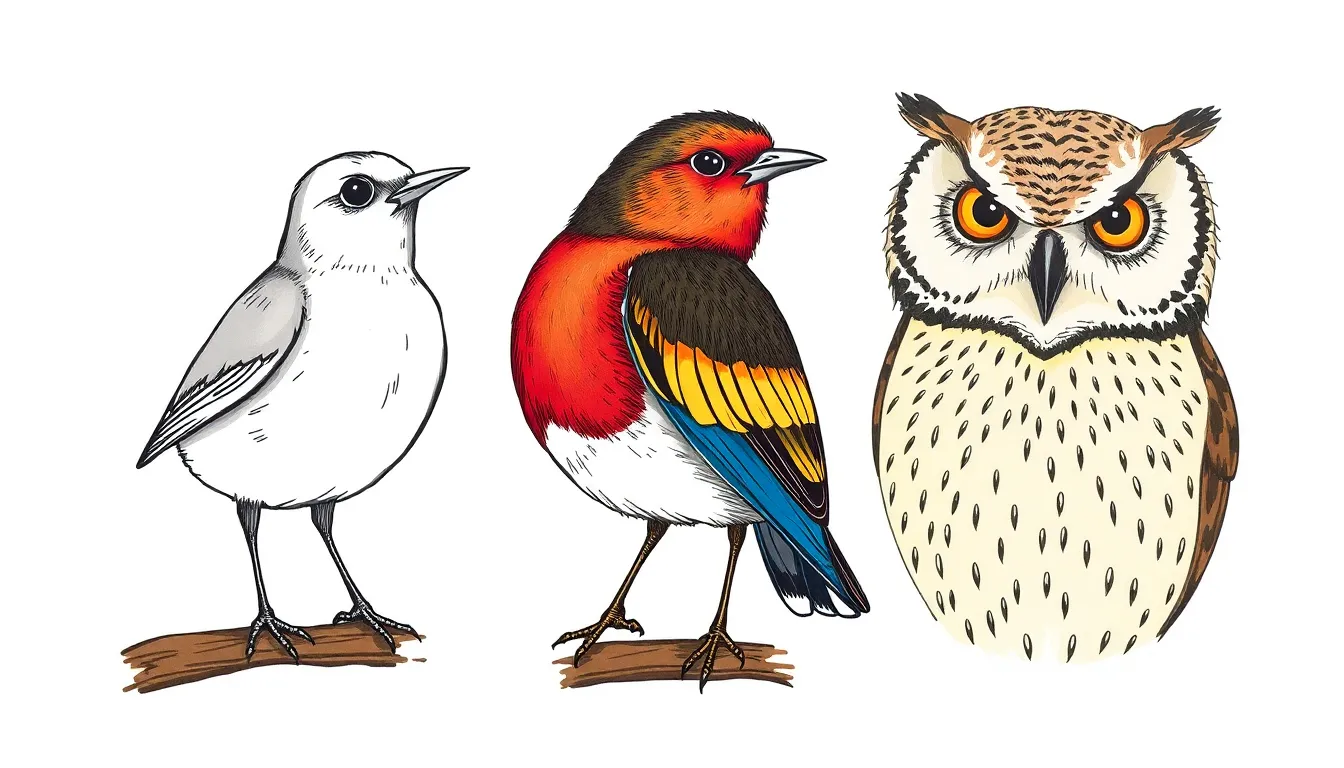
We’ll guide you through three detailed tutorials that transform your basic bird doodle skills into confident artistic expressions. These step by step instructions build upon the fundamental techniques we’ve covered to create recognizable bird characters.
Drawing a Simple Sparrow
We start our sparrow tutorial with a small circle for the head, positioned slightly to the left of your drawing space. Draw an oval below and to the right of the head circle, making it about twice the size to form the sparrow’s rounded body.
Connect the head to the body using two curved lines that create the neck area. Add a small triangular beak pointing to the left from the head circle, keeping the triangle narrow and slightly curved downward.
Sketch the tail using three overlapping teardrop shapes extending from the right side of the body oval. Draw the wing as a curved line that starts from the top of the body and sweeps down toward the tail area.
Place a small dot for the eye inside the head circle, positioning it above the beak area. Add thin stick like legs beneath the body using two straight lines with small claws at the bottom.
Finish your sparrow by adding texture lines to the wing and tail feathers using short parallel strokes. Include tiny details like nostril dots on the beak and feather patterns along the body.
Creating a Colorful Robin
We begin the robin tutorial by drawing a slightly larger head circle than our sparrow example, as robins have more prominent heads. Create an oval body shape below the head, making it rounder and fuller than the sparrow’s frame.
Add the robin’s distinctive orange red breast by drawing a curved line across the upper body oval. Sketch a short pointed beak extending from the head circle, keeping it thinner than the sparrow’s beak.
Draw the robin’s wing using a teardrop shape that covers about half of the body oval area. Create the tail with three fan shaped sections extending from the back of the body.
Include the robin’s characteristic black eye as a filled circle within the head area. Add sturdy legs using slightly thicker lines than the sparrow, with three forward facing toes and one backward toe.
Apply colors using orange or red for the breast area, brown tones for the back and wings, and gray shades for the head. Use white for highlighting the belly area and black accents around the eye and wing details.
Enhance your colorful robin with subtle shading beneath the wing and along the body curves. Add small feather textures using short curved lines throughout the colored areas.
Sketching an Owl Face
We approach the owl face tutorial by starting with a large circle that will cover the entire facial disc area. Draw two overlapping circles within this main circle, positioning them in the upper portion to create the distinctive eye placement.
Create the owl’s facial disc by adding a heart shaped outline around the main circle, with the point of the heart forming the lower beak area. Sketch two large circular eyes within the overlapping circles, filling them with smaller circles for pupils.
Add the owl’s beak as a small downward pointing triangle positioned between and below the large eyes. Draw feather tufts above each eye using jagged curved lines that extend upward from the facial disc.
Include detailed feather patterns around the facial disc using short curved lines that radiate outward from the center. Create depth around the eyes by adding circular rings of small curved strokes.
Finish the owl face with shading techniques that emphasize the large eyes and create dimension. Use darker tones around the outer edges of the facial disc and lighter values near the center eye area.
Add personality to your owl through subtle variations in eye size or tilt, and experiment with different feather tuft angles for unique expressions.
Creative Bird Doodle Ideas for Inspiration
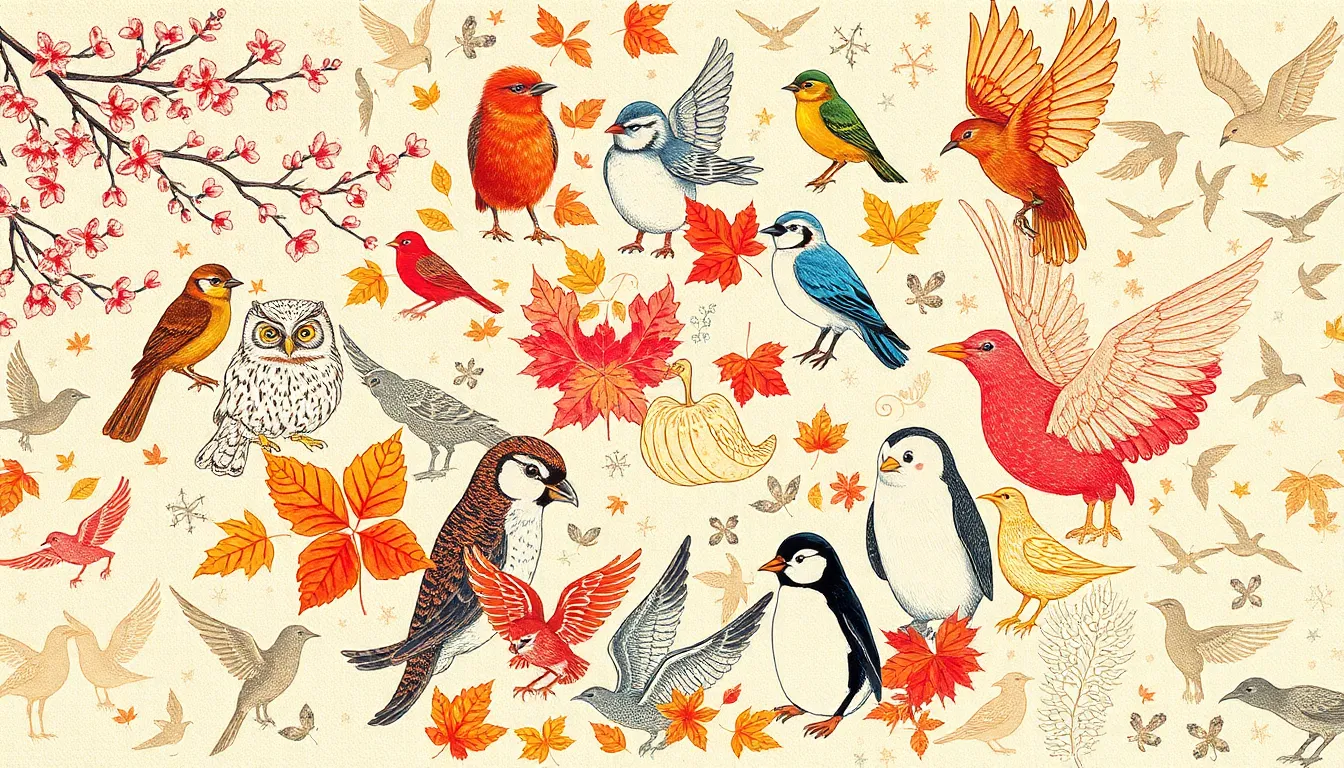
Transform your basic bird doodle skills into unique artistic expressions with these inspiring design concepts. We’ve compiled creative approaches that’ll spark your imagination and help you develop your personal bird doodling style.
Seasonal Bird Themes
Spring bird doodles capture the essence of renewal with robins perched on blooming branches and sparrows building nests among fresh green leaves. Create delicate cherry blossom scenes featuring small songbirds or draw baby birds emerging from decorated Easter eggs. Summer designs showcase tropical birds like parrots surrounded by palm fronds and hibiscus flowers.
Autumn bird themes feature migrating geese in V-formations across golden skies and owls nestled among colorful fall foliage. Draw cardinals against bare winter branches dusted with snow or create cozy scenes of birds at backyard feeders. Winter doodles work beautifully with penguins sliding on ice or small birds seeking warmth in snow-covered evergreen trees.
Holiday variations add festive elements to seasonal bird designs. Christmas birds wear tiny Santa hats or carry holly sprigs in their beaks. Halloween owls sport witch hats while Thanksgiving turkeys display elaborate tail feathers decorated with autumn leaves.
Bird Doodle Patterns and Borders
Repetitive bird silhouettes create stunning pattern designs when arranged in flowing formations across your page. Use identical sparrow shapes spaced evenly to form geometric borders or vary the bird sizes for ever-changing visual rhythm. Chain small bird outlines together to create decorative frames around journal pages or greeting cards.
Migration patterns offer natural inspiration for border designs with V-shaped formations of geese or swallows creating elegant page dividers. Circular arrangements of flying birds make beautiful mandala-style patterns perfect for meditation or zentangle art. Linear borders featuring perched birds on branches transform plain notebook margins into artistic masterpieces.
Mixed species borders combine different bird types like owls, cardinals, and hummingbirds in alternating sequences. Create wave patterns using bird silhouettes that flow like ocean currents across your paper. Scattered bird arrangements work well as background patterns for quotes or poems about nature.
Fantasy and Mythical Bird Designs
Phoenix doodles bring legendary fire birds to life with flowing tail feathers and flame-like details radiating from their wings. Draw these majestic creatures rising from decorative ashes or soaring through star-filled skies. Peacock-phoenix hybrids combine the elegance of peacock plumage with mythical fire elements.
Dragon-bird combinations merge reptilian features with feathered wings creating unique fantasy creatures. Add scales to bird necks or give owls small horns and dragon-like claws. Griffins offer another mythical option blending eagle heads with lion body proportions in your doodle designs.
Angel birds feature ethereal qualities with multiple wings, halos, or celestial backgrounds filled with clouds and stars. Steampunk bird designs incorporate mechanical elements like gear-decorated wings or clockwork tail feathers. Fairy tale birds might include tiny crowns, magical wands in their beaks, or sparkles surrounding their flight paths.
Digital Bird Doodle Tools and Apps
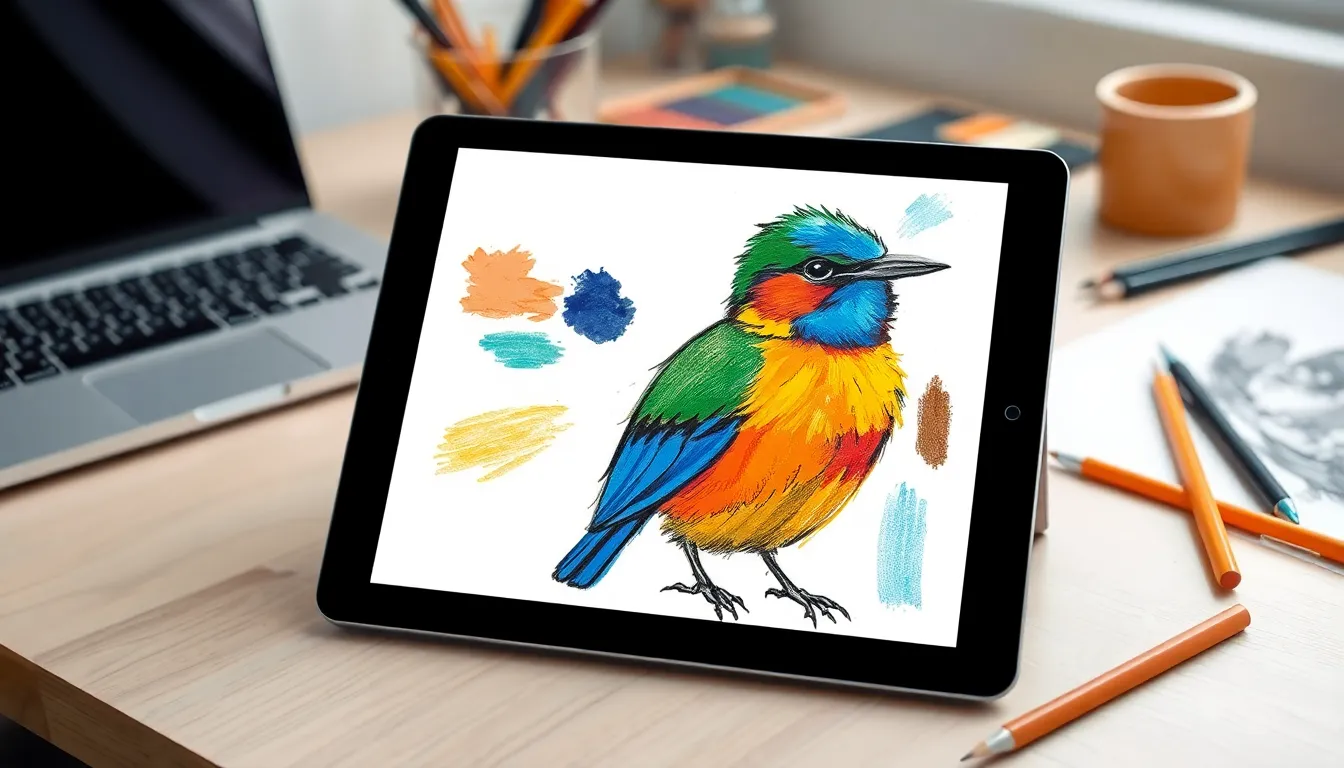
Modern technology transforms traditional bird doodling into ever-changing digital experiences. We’ll explore powerful applications and resources that enhance our creative process.
Best Tablet Drawing Applications
Procreate leads tablet drawing applications with intuitive bird doodle features and natural brush responses. We get access to thousands of brushes, layer management tools, and animation capabilities that bring our feathered sketches to life. Apple iPad users particularly benefit from Procreate’s pressure-sensitive drawing engine and seamless Apple Pencil integration.
Adobe Fresco combines vector and raster drawing tools for versatile bird illustration workflows. We can switch between precise vector lines for clean silhouettes and watercolor brushes for organic textures. Cloud synchronization keeps our bird doodle projects accessible across multiple devices.
Clip Studio Paint offers professional-grade features specifically designed for detailed bird artwork and character design. We access specialized feather brushes, 3D bird reference models, and advanced animation tools. Comic and manga artists especially appreciate the extensive customization options for cartoon-style bird characters.
ArtRage simulates traditional art materials with realistic oil paint and watercolor effects for our digital bird doodles. We can blend colors naturally and create textured backgrounds that mimic canvas or paper surfaces. Beginners find the interface familiar since it mimics real-industry painting techniques.
Free Online Bird Doodle Resources
Sketchpad.io provides browser-based drawing tools without software installation requirements. We can create bird doodles directly in our web browser using basic brushes, shapes, and color palettes. Students and casual artists benefit from the immediate accessibility and simple sharing options.
Google Canvas integrates seamlessly with Google Classroom and Drive for educational bird doodle projects. We get collaborative features that allow multiple users to work on the same bird illustration simultaneously. Teachers particularly value the automatic saving and easy assignment distribution capabilities.
Krita delivers professional illustration features as completely free desktop software for detailed bird artwork. We access advanced brush engines, animation tools, and extensive customization options without subscription fees. Open source development ensures regular updates and community-driven improvements.
GIMP offers comprehensive image editing capabilities for improving our scanned traditional bird doodles. We can adjust colors, add digital effects, and combine multiple sketches into cohesive compositions. Photographers often use GIMP to create mixed-media bird art incorporating photos and drawings.
Digital Brushes and Textures
Feather brushes create realistic plumage textures with single brush strokes rather than individual line work. We can adjust opacity, size, and scatter settings to achieve different feather types from soft down to rigid flight feathers. Watercolor feather brushes work particularly well for impressionistic bird portraits.
Stippling brushes generate natural bird textures through dot patterns that mimic traditional pen and ink techniques. We control density and randomness to create realistic shading on bird bodies and wings. Cross-hatching variations add depth and dimension to our digital bird doodles.
Watercolor texture overlays add organic backgrounds and atmospheric effects to our bird illustrations. We can layer cloud textures, paper grain, and color washes to create environmental contexts for our feathered subjects. Vintage paper textures work especially well with nostalgic bird doodle styles.
Custom shape brushes speed up repetitive elements like bird silhouettes, wing patterns, and flock formations. We create our own brush sets from successful bird doodles and reuse them across multiple projects. Migration pattern brushes help us design decorative borders and repeated motifs efficiently.
Bird Doodle Projects for Different Skill Levels
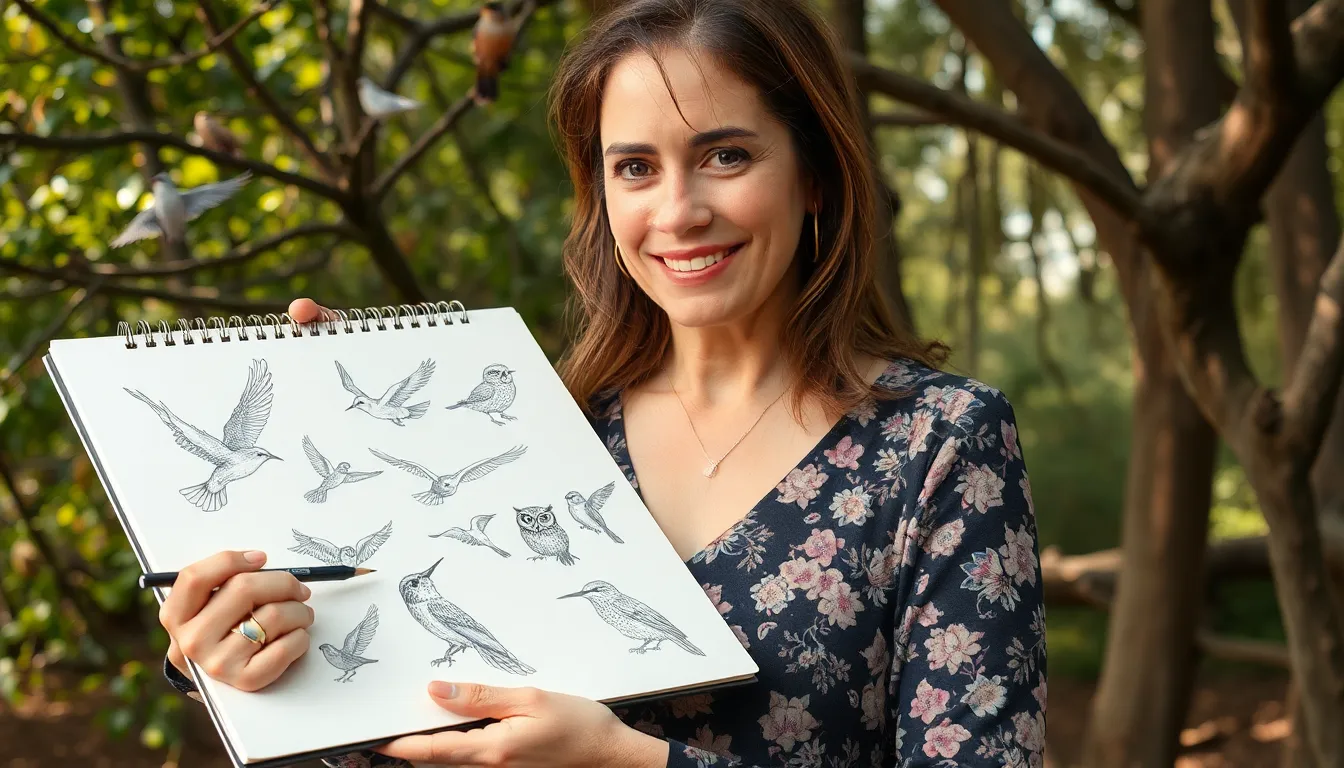
We’ve organized these bird doodle projects by complexity to match your current artistic abilities and time availability.
Quick 5-Minute Bird Sketches
Flying birds in motion capture the essence of movement with just a few strategic strokes. We recommend starting with basic V shapes for distant birds then adding curved wing lines to show flight dynamics. Simple sparrows work perfectly for these rapid sketches since their compact bodies require minimal detail work.
Perched bird silhouettes offer excellent practice for understanding proportions without getting caught up in complex features. We focus on the head to body ratio and tail positioning to create recognizable shapes. Small songbirds like finches provide ideal subjects because their rounded forms translate easily into quick doodle formats.
Side profile birds showcase the classic bird shape that most people recognize instantly. We emphasize the beak angle and eye placement to establish character in these speedy sketches. Cardinals and blue jays make excellent subjects since their distinctive crests add visual interest without requiring extensive detail work.
Detailed Bird Portrait Studies
Owl face studies demand careful attention to the distinctive facial disc and large forward facing eyes. We start with circular guidelines then build up the layered feather patterns around the eyes and beak area. Great horned owls provide excellent reference material due to their striking ear tufts and intense gaze.
Hummingbird anatomy challenges artists to capture the delicate proportions and intricate wing details of these tiny creatures. We focus on the needle like beak and compact body structure while paying special attention to wing positioning. Ruby throated hummingbirds offer beautiful color variations and clear anatomical features for study purposes.
Raptor head portraits require understanding of the powerful beak structure and intense eye expressions that define birds of prey. We emphasize the curved talons and sharp facial features that give these birds their commanding presence. Red tailed hawks and peregrine falcons provide excellent subjects with their distinctive markings and fierce expressions.
Bird Doodle Art Journals
Daily bird observation pages combine quick sketches with written notes about behavior and habitat details. We suggest dedicating one page per day to documenting local bird species you encounter during walks or through window watching. Robins and house sparrows make frequent appearances and offer consistent practice subjects throughout different seasons.
Migration pattern spreads document seasonal bird movements through your area using simple maps and flight path illustrations. We create visual timelines showing when different species arrive and depart from your region. Geese formations and swallow migration patterns provide ever-changing subjects that change throughout the year.
Feather texture studies explore different drawing techniques for representing various feather types found across bird species. We practice creating scales for water birds, soft down for songbirds, and precise flight feathers for raptors. Mallard ducks and mourning doves offer diverse feather textures within easily observable local species.
Common Bird Doodle Mistakes to Avoid
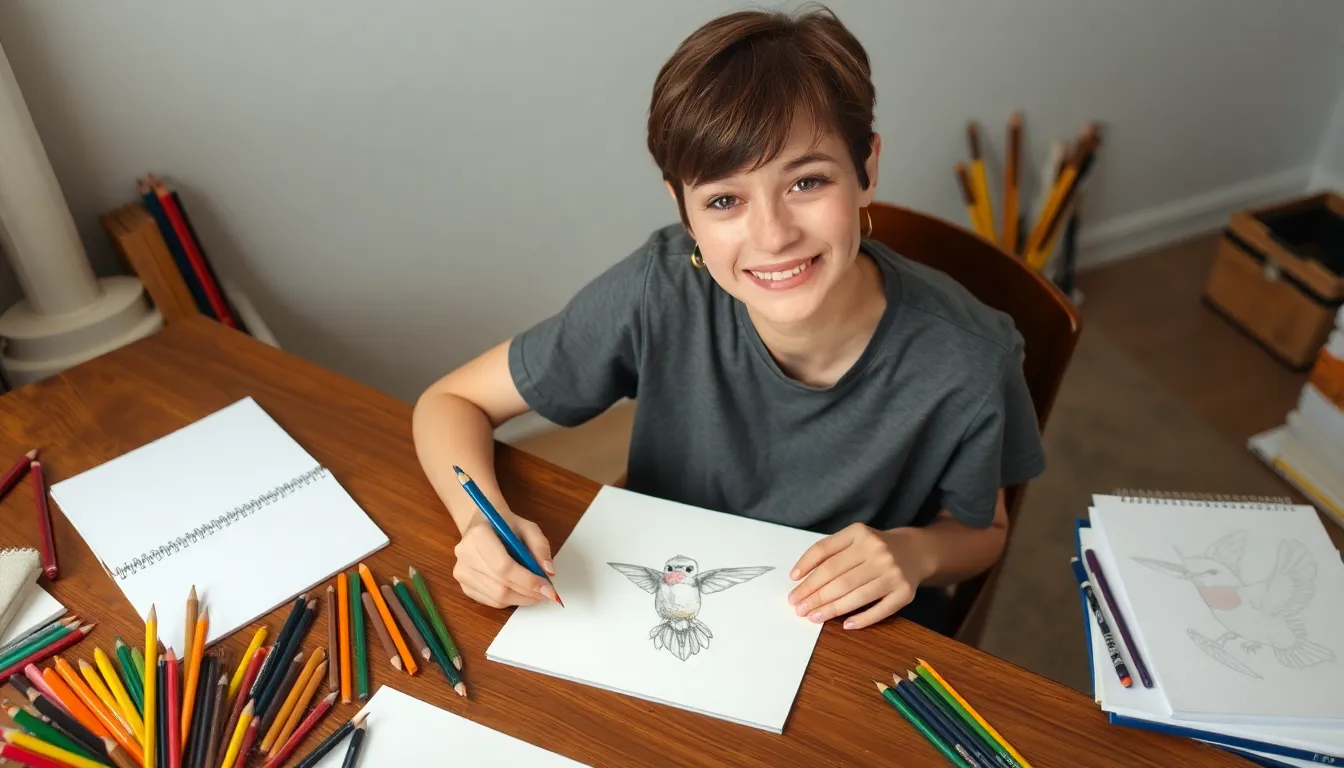
Understanding common pitfalls helps us create more successful bird doodles. Recognizing these frequent errors prevents frustration and accelerates our artistic progress.
Proportion and Anatomy Errors
Disproportionate head sizes create the most noticeable mistakes in bird doodles. We often draw heads too large compared to the body, making our birds appear cartoonish when we’re aiming for realism. The head should typically be about one third the size of the body for most songbirds.
Incorrect wing placement disrupts the natural flow of our bird sketches. Wings attach to the upper back area, not the middle of the body as many beginners assume. Drawing wings too low makes birds look anatomically impossible.
Oversized or undersized beaks throw off the entire bird’s character. We need to study our reference species carefully since beak size varies dramatically between birds like hummingbirds and pelicans. A robin’s beak should be small and pointed, while a cardinal’s is thicker and more triangular.
Misplaced eye positioning affects the bird’s expression and realism. Eyes sit on the sides of most birds’ heads, not facing forward like human eyes. Placing them too high or too low changes the species entirely.
Overcomplicating Simple Designs
Adding excessive detail overwhelms simple bird doodles and defeats their charming simplicity. We often feel compelled to include every feather and marking, but effective doodles capture essence rather than photographic accuracy. Three or four well placed lines can suggest wing feathers better than dozens of detailed strokes.
Creating busy backgrounds competes with our main subject for attention. Simple bird doodles work best with minimal or no background elements. A single branch or basic ground line provides context without distraction.
Using too many line weights creates visual chaos in our drawings. Consistent line thickness throughout the doodle maintains harmony and readability. We can vary thickness slightly for emphasis, but dramatic changes make sketches look unfinished.
Mixing incompatible styles within a single doodle confuses viewers and weakens the overall impact. Combining realistic shading with cartoon proportions or detailed feathers with simplified bodies creates inconsistent results.
Color and Shading Problems
Applying harsh black shadows makes bird doodles appear heavy and unnatural. We should use lighter grays or colored shadows that complement our bird’s natural tones. Soft gradients work better than stark contrasts for most species.
Choosing unrealistic color combinations immediately signals amateur work to viewers. Even stylized birds benefit from color schemes inspired by real species. A bright purple robin might work for fantasy art, but traditional doodles need believable hues.
Ignoring light source direction creates confusing shadows and highlights throughout our drawings. We must establish where light comes from and maintain consistent shading across all elements. Mixed lighting makes birds appear flat or dimensionally incorrect.
Overusing bright colors overwhelms the delicate nature of bird doodles. Most birds feature subtle, muted tones with small areas of bright color for accent. A cardinal’s red should be the focal point, not competing with equally bright background elements.
Blending colors incorrectly muddles our intended effects and creates dirty looking results. We need to understand how different mediums blend, whether we’re using colored pencils, markers, or digital tools. Clean color transitions require practice and proper technique.
Using Bird Doodles in Everyday Art

Bird doodles transform ordinary projects into meaningful artistic expressions through simple yet impactful additions. We can incorporate these versatile sketches into many daily creative endeavors to add charm and personality.
Greeting Card Decorations
Handmade greeting cards gain instant appeal with thoughtfully placed bird doodle accents. We create birthday cards featuring cheerful songbirds perched on branch borders, adding warmth to our personal messages. Holiday cards showcase seasonal bird themes like cardinals for Christmas, doves for peace themed occasions, and robins for Easter celebrations.
Corner decorations work particularly well for formal greeting cards. We draw small bird silhouettes in card corners using fine tip pens, creating elegant frames without overwhelming the main message. Wedding invitations benefit from delicate dove pairs or love birds positioned near text blocks, symbolizing unity and new beginnings.
Interactive pop up elements bring greeting cards to life through dimensional bird designs. We fold paper wings that extend when recipients open cards, creating memorable moments that recipients treasure. Simple cut out bird shapes attached to card interiors create shadow effects that add depth and visual interest to our handmade creations.
Bullet Journal Embellishments
Monthly spreads become more captivating with bird themed decorative elements throughout planning pages. We incorporate flying bird silhouettes along header borders, creating movement that guides eyes across journal layouts. Seasonal bird motifs help organize monthly themes, with migrating geese for autumn pages and nesting birds for spring planning sections.
Habit trackers transform into artistic displays when we integrate bird doodle reward systems. We draw small bird icons that get colored in as daily goals are met, creating visual progress indicators that motivate continued success. Migration pattern tracking mimics bird flight paths, turning routine habit monitoring into creative artistic expression.
Weekly layout dividers benefit from repetitive bird doodle patterns that separate different planning sections. We create borders using alternating bird silhouettes and branch elements, establishing clear visual boundaries between work tasks, personal goals, and creative projects. Small perched birds serve as bullet points for important tasks, making to do lists more visually appealing and memorable.
Social Media Art Posts
Instagram stories gain increased engagement when we feature quick bird doodle tutorials in time lapse format. We record simple sparrow drawings from start to finish, showing followers our creative process in digestible 15 second segments. Daily doodle challenges encourage community participation, with followers sharing their own bird interpretations using exact hashtags we create.
Pinterest boards dedicated to bird doodle collections attract create enthusiasts seeking inspiration for their own projects. We organize pins by difficulty level, seasonal themes, and artistic styles, helping users find exactly what matches their current skill level. Step by step photo tutorials perform particularly well, with each image showing clear progression from basic shapes to finished bird illustrations.
Facebook art groups respond positively to bird doodle sharing posts that encourage community interaction and feedback. We share work in progress photos asking for color suggestions or technique advice, fostering collaborative artistic growth. Live drawing sessions allow real time interaction with followers, answering questions while demonstrating bird doodle techniques that viewers can immediately practice themselves.
Building Your Bird Doodle Style
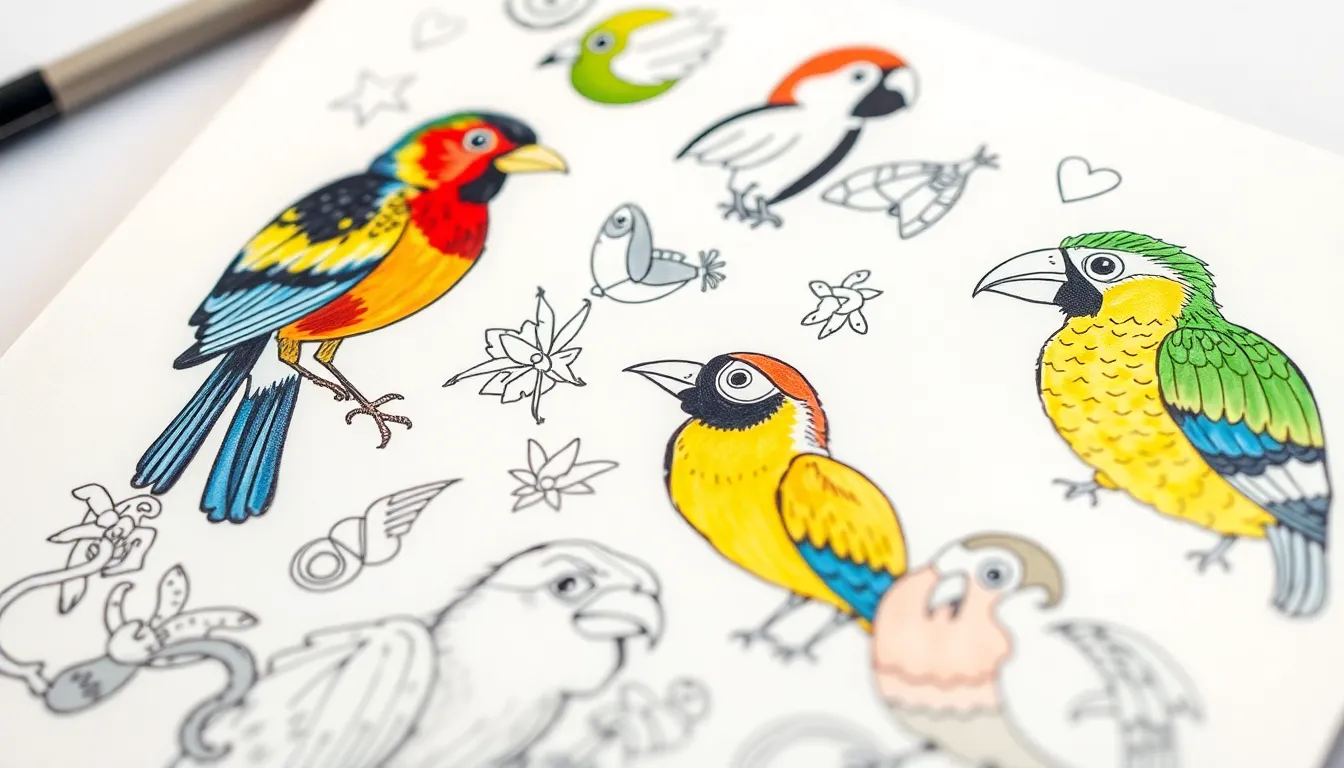
Developing a unique bird doodle style transforms casual sketching into personalized artistic expression. We’ll explore how to discover your creative voice and build a distinctive approach to bird illustration.
Finding Personal Artistic Voice
Observe artists whose work resonates with your aesthetic preferences. Study their line quality, composition choices, and approach to bird anatomy. Instagram artists like @birdsonthebrain and @featheredfiends showcase diverse approaches from whimsical cartoon styles to detailed naturalistic sketches.
Experiment with different drawing tools to discover your preferred medium. Brush pens create flowing organic lines perfect for graceful swan necks, while fine liners excel at crisp robin silhouettes. Pencils offer versatility for soft owl feathers, and digital styluses provide unlimited color possibilities for tropical parrots.
Analyze your natural drawing tendencies during practice sessions. Notice whether you gravitate toward rounded shapes like robins and chickadees, or angular forms like hawks and eagles. Document these preferences in your sketchbook to identify emerging patterns.
Combine influences from unexpected sources beyond bird art. Fashion illustration techniques can enhance tail feather details, while manga styles might inspire expressive cardinal eyes. Architectural drawings offer insights into creating structured nest environments.
Developing Consistent Character Features
Establish signature eye shapes that appear across all your bird doodles. Circular eyes with small highlights work well for friendly songbirds, while almond shapes suit raptors and water birds. Maintain consistent pupil positioning and reflection placement for visual unity.
Create a standardized approach to beak proportions and angles. Seed-eating birds like finches need short triangular beaks, while hummingbirds require long curved ones. Develop a personal interpretation that maintains species accuracy while reflecting your artistic style.
Design consistent wing patterns that enhance your birds’ personalities. Simplified feather groupings work better than individual feather details for maintaining style cohesion. Consider using three-segment wing divisions: shoulder, middle, and flight feathers.
Develop signature tail shapes that complement your overall aesthetic. Forked swallow tails, fan-shaped robin tails, and pointed jay tails should follow your established line quality and proportional relationships. Keep tail positioning consistent relative to body angle.
Creating a Bird Doodle Portfolio
Document your progress with dated sketches organized by species categories. Create sections for songbirds, raptors, water birds, and game birds to showcase your range. Include both quick gesture drawings and detailed studies to demonstrate versatility.
Photograph your work using consistent lighting and backgrounds. Natural daylight near a window eliminates harsh shadows while maintaining color accuracy. Use a neutral gray or white backdrop to prevent visual distractions from your artwork.
Develop themed collections that demonstrate your style evolution. Seasonal bird series show adaptability, while anatomical studies highlight technical skills. Migration patterns, nesting behaviors, and feeding habits provide rich subject matter for cohesive collections.
Create digital presentations showcasing your strongest pieces first. Instagram grids work well for displaying nine related doodles, while Pinterest boards allow longer collections. Include work-in-progress shots and time-lapse videos to engage viewers with your creative process.
Write brief artist statements explaining your bird doodle philosophy. Describe what draws you to certain species, your preferred tools, and artistic goals. Share stories about memorable sketching experiences or conservation messages that inspire your work.
Conclusion
Bird doodling offers an accessible and rewarding artistic journey that connects us with nature while developing our creative skills. Whether we’re sketching quick 5-minute silhouettes or crafting detailed portraits we’re building a foundation that grows stronger with each stroke.
The beauty of bird doodles lies in their versatility – they can enhance our journals transform into digital masterpieces or become meaningful gifts. As we develop our unique style and avoid common pitfalls our confidence naturally flourishes.
We encourage you to grab a pencil and start your bird doodling adventure today. Remember that every expert artist began with simple lines and basic shapes. Your artistic voice is waiting to take flight.
Frequently Asked Questions
What are bird doodles and why are they popular?
Bird doodles are simple sketches or drawings of birds that range from basic silhouettes to intricate designs. They’re popular because they offer a universal form of artistic expression that appeals to both beginners and experienced artists. Bird doodles serve as an accessible creative outlet that doesn’t require advanced skills or expensive materials to get started.
What basic materials do I need to start bird doodling?
You only need a few essential supplies: standard pencils for sketching, fine tip pens for clean lines, and smooth drawing paper for optimal results. Optional materials include colored pencils, markers, or erasers to enhance your doodles. The beauty of bird doodling is that you can start with whatever basic drawing supplies you already have at home.
What are the easiest bird doodle techniques for beginners?
Start with basic line drawing using curved lines to create natural bird shapes, or try single stroke techniques for minimalist designs. Shape-based approaches work well too – use circles for heads, ovals for bodies, and triangles for beaks and tails. These fundamental methods help you build recognizable bird features without requiring advanced drawing skills.
What are the most popular bird doodle styles?
The three most popular styles are minimalist single-line birds, cartoon-style bird characters, and realistic bird sketching. Single-line drawings capture bird essence with continuous strokes, cartoon styles use exaggerated features for expressive characters, and realistic sketching focuses on anatomical accuracy with detailed shading techniques.
Can I create bird doodles digitally?
Yes! Popular tablet apps like Procreate, Adobe Fresco, and Clip Studio Paint offer excellent tools for digital bird doodling. Free online platforms like Sketchpad.io and Google Canvas provide accessible alternatives. Digital tools offer unique brushes, textures, and effects that can enhance your bird illustrations and streamline your creative workflow.
How can I avoid common bird doodle mistakes?
Focus on proper proportions by keeping heads appropriately sized and wings correctly placed. Avoid overcomplicating designs with excessive detail or busy backgrounds. Use realistic color combinations, establish consistent light sources, and avoid harsh contrasts in shading. Remember that simplicity often creates more impactful and appealing bird doodles.
How can I use bird doodles in everyday projects?
Bird doodles work beautifully in handmade greeting cards, bullet journal decorations, and social media art posts. You can create seasonal themes, habit trackers, and layout dividers. They’re also perfect for art journals, migration pattern documentation, and feather texture studies that enhance your artistic practice and daily creativity.
How do I develop my own unique bird doodle style?
Study artists whose work resonates with you and experiment with different drawing tools to find your preferred medium. Develop consistent character features like signature eye shapes, beak proportions, and wing patterns. Document your progress through a portfolio, organize sketches by species, and create themed collections that showcase your style evolution over time.

